#arisaema triphyllum
Text
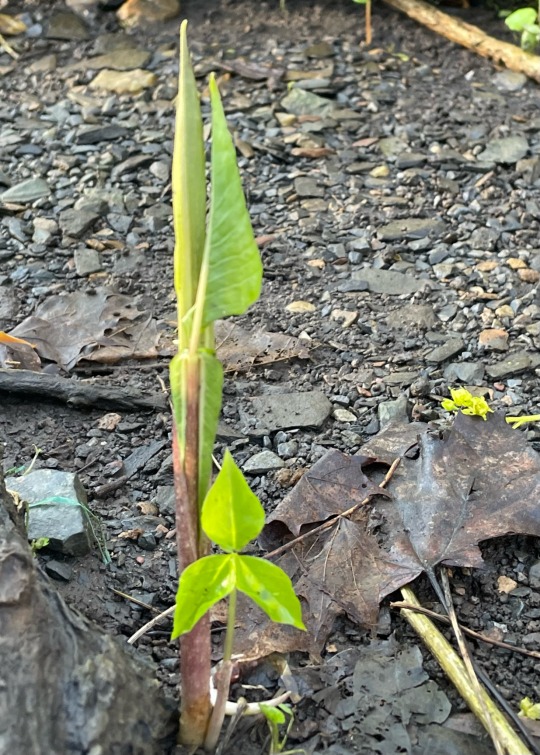
Be ready. Jack is setting up the pulpit and will be preaching the gospel of the woodland and singing hymns of the water over stones.
#plants#plantblr#jack in the pulpit#arisaema#pennsylvania#arisaema triphyllum#april#spring#springtime
125 notes
·
View notes
Text
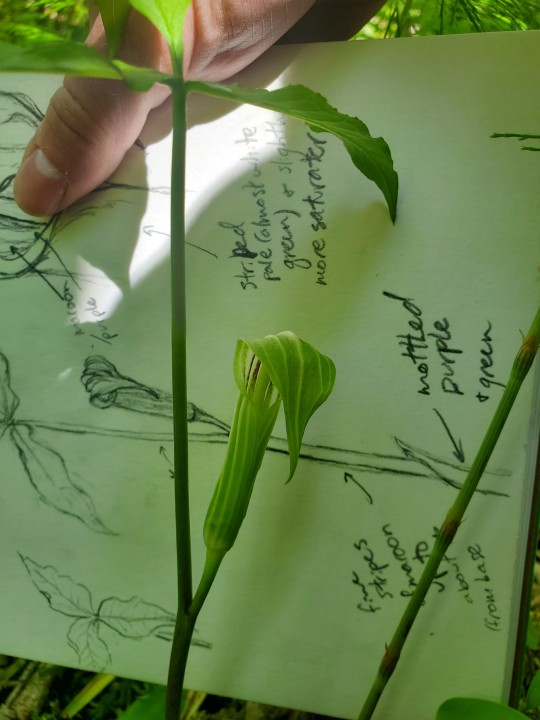

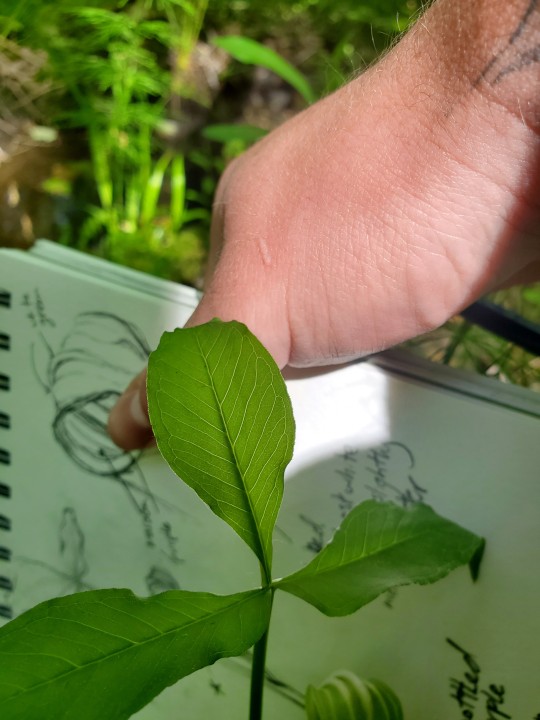
Today's plant is Arisaema triphyllum, also known as Jack-in-the-Pulpit. (photos are mine)
A. triphyllum is actually a species complex of four (or five, depending on who you talk to) closely related species. All species are native to Eastern North America and are found in deep, moist soils rich in organic matter. This group is still undergoing lots of debate in the taxonomy world, and the exact grouping and lineages are not fully known.
This species complex is part of the family Araceae, which is an incredibly cool (in my opinion) and diverse family that predominantly lives in the tropics of South American and eastern Asia.
Like most of its relatives, it attracts pollinators (at least in part) through deceptive scent compounds, which are volatilized and spread under exposure to heat. Unlike many of its relatives, Jack-in-the-Pulpit does not appear to utilize thermogenesis (active metabolic heat production) in its flowering parts to achieve this--it is posited that absorbed heat from the sun is sufficient for them to release these compounds! (Barriault et al. 2009)
Another trait it shares with almost all of its relatives is a very particular defense strategy: tiny, tiny knives. Its shiny red fruits might look tasty to some, but beware: the sensation of biting into it has been described by those brave (read: foolish) souls who've tried it as "like chewing glass."
This sensation is caused by tiny daggers of crystalline calcium oxalate (called raphides) being forcibly ejected from their cells right into your tender mouth parts by the force of your own chewing. Now that's what I call retribution!
76 notes
·
View notes
Photo

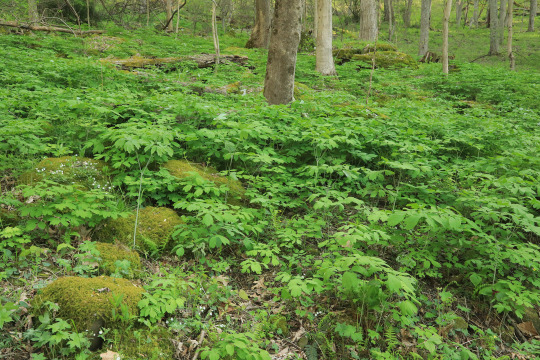
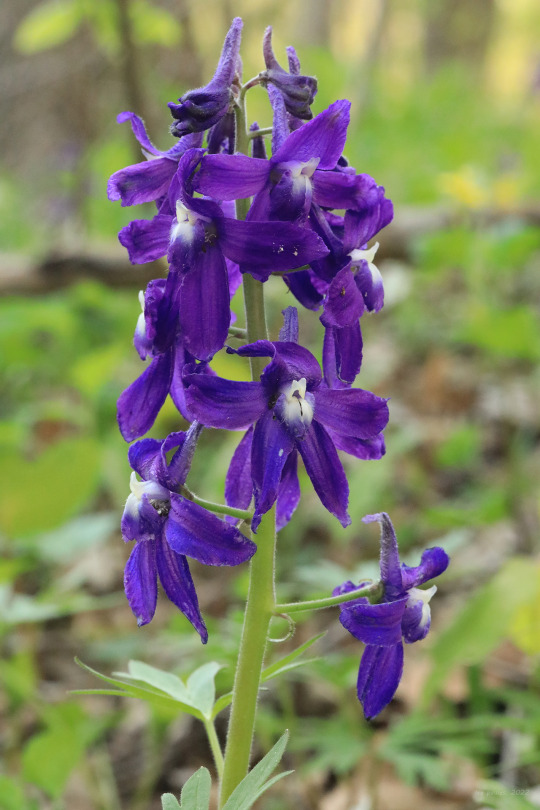
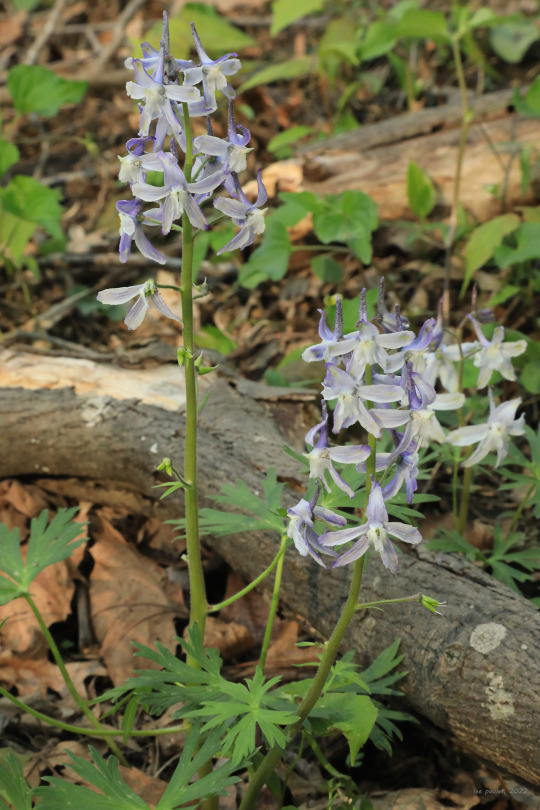
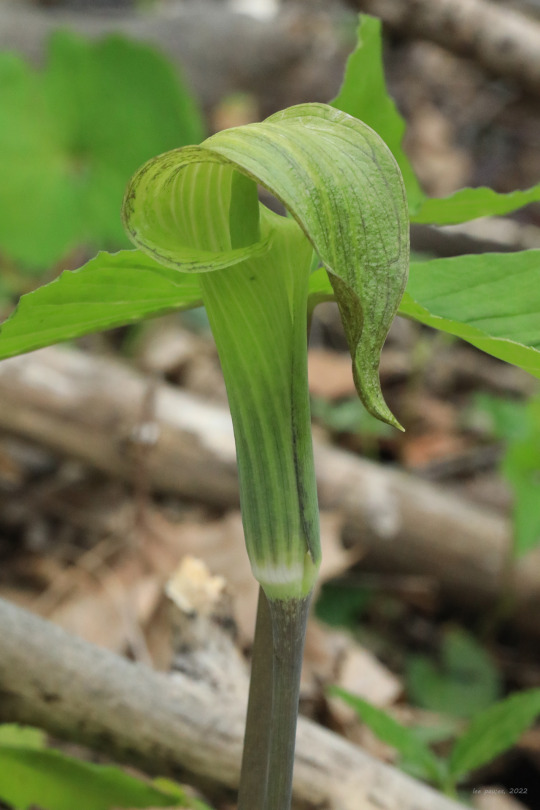

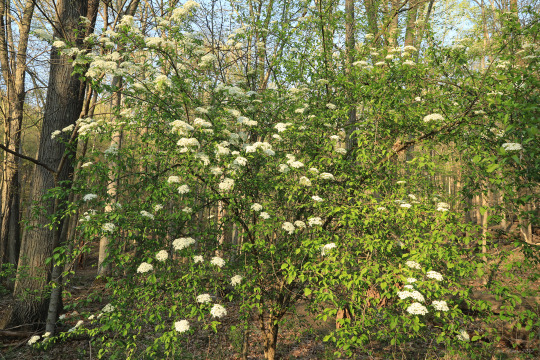
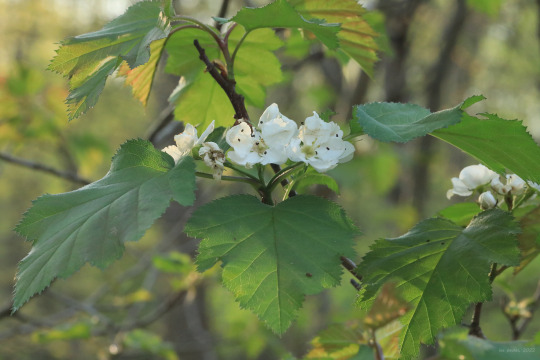
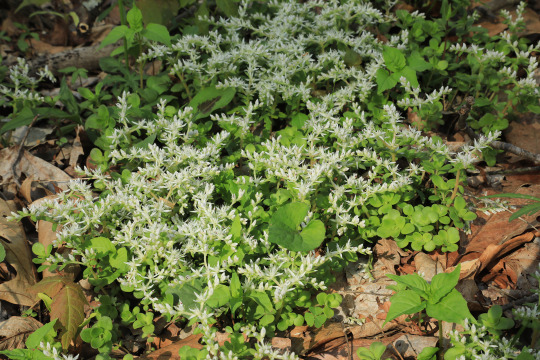
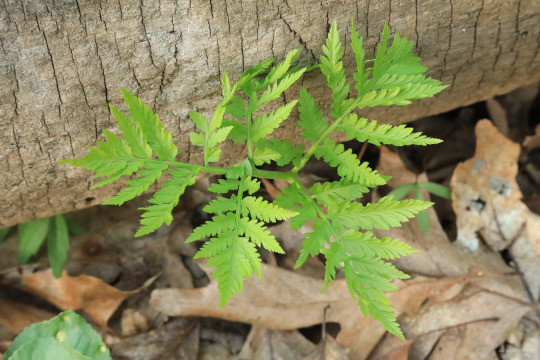
Elizabeth’s Woods, part of the Toms Run Preserve system, is located just a few minutes from where I work: a convenient little Eden on whose gentle, winding trails I frequently relieve my accumulated angst and stress. In early spring, especially in the late afternoon, the old woods take on a soft, burnished glow that penetrates every leaf and flower, exposing nature’s finest filigree - veins, venules, stigmas, anthers and more - in intricate detail.
From top: a rocky alcove overrun by giant blue cohosh (Caulophyllum giganteum); a purple variation of dwarf larkspur (Delphinium tricorne), a toxic little beauty whose flowers remind me of parachuting wizards; an even lovelier lavender and white variation of the same plant; a tall and stately Jack-in-the pulpit (Arisaema triphyllum); a smooth blackhaw viburnum (Viburnum prunifolium), equally beautiful in spring and fall, when its foliage turns reddish-purple; bigfruit hawthorn (Crataegus macrosperma) with new spring blossoms; woodland stonecrop (Sedum ternatum), whose massed white flowers look like clumps of snow in the leaf litter; and an unfurling Virginia grape fern (Botrypus virginianus), also known as rattlesnake fern due to its tendency to grow in the same habitats in which rattlesnakes occur.
#appalachia#vandalia#west virginia#spring#flora#wildflowers#caulophyllum giganteum#giant blue cohosh#delphinium tricorne#dwarf larkspur#arisaema triphyllum#jack-in-the-pulpit#viburnum prunifolium#blackhaw viburnum#smooth blackhaw viburnum#crataegus macrosperma#bigfruit hawthorn#sedum ternatum#woodland stonecrop#botrypus virginianus#virginia grape fern#rattlesnake fern#elizabeth's woods#toms run preserve#west virginia land trust
145 notes
·
View notes
Text

Ohio Spring Wildflower Field Guide
#flower#flowers#spring flowers#spring#floral#wildflowers#wild flowers#ohio#ohio wild flowers#botany#april#march#may#jack-in-the-pulpit#jack in the pulpit#arisaema triphyllum
0 notes
Text
some neat looking plants I've seen recently
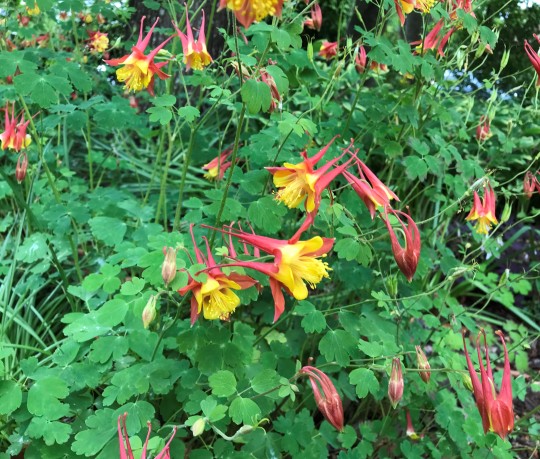
wild red Columbines (Aquilegia canadensis)
Found at a church.

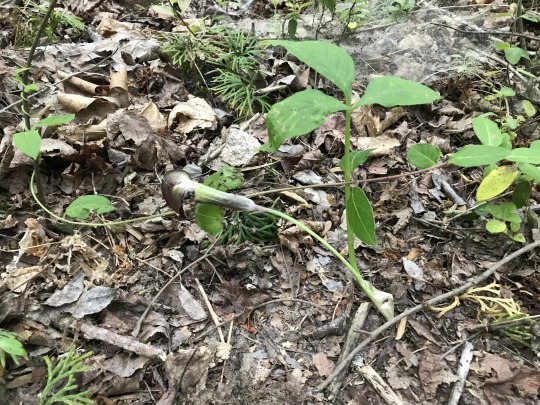
Jack-in-the-pulpit (Arisaema triphyllum)
Found this while hiking. I didn't know what it was and I didn't have anything to take a picture of it with when I first saw it, so I went back the next day. Apparently part of it is ""edible"", but only after cooking. Otherwise it tastes like burning and poisons you. :)
1 note
·
View note
Text
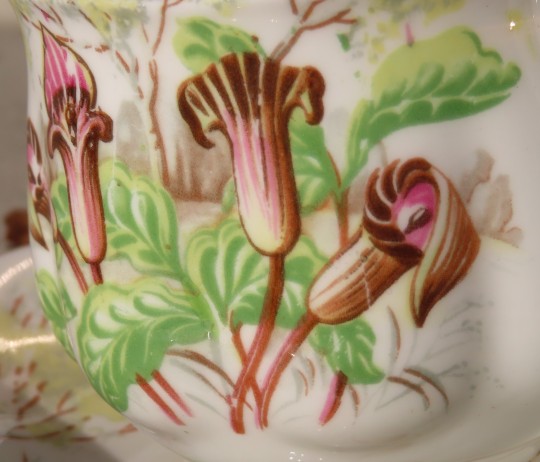


Arisaema triphyllum (Jack-in-the-pulpit)
Jack and Jill
Jack-in-the-pulpit is a species native to eastern North America. The inflorescence can be male (with male flowers only), bisexual (with both male and female flowers), or female (with female flowers only).
As the Arisaema grows, individuals change sex in a pattern determined by their size. In a small plant, all of the flowers are male. As the plant matures and grows larger, the spadix produces female flowers as well as male flowers. When full grown, Jack-in-the-pulpit becomes Jill-in-the-pulpit and produces female flowers only. This reproductive system is called 'sequential hermaphroditism' and it's rare, known only in a very small number of flowering plant species.
Meanwhile, back at the tea cup collection...
Royal Albert, Jack-in-a-Pulpit, Bone China tea cup and saucer
#flowers#photographers on tumblr#Jack-in-the-pulpit#Royal Albert#tea cups#fleurs#flores#fiori#blumen#bloemen#V
81 notes
·
View notes
Text

Jack-in-the-Pulpit (Arisaema triphyllum)
Family: Arum Family (Araceae)
IUCN Conservation Status: Unassessed
Also known as the Bog Onion or Brown Dragon Arum, the Jack-in-the-Pulpit is a small and highly unusual plant found across much of eastern North America. Growing to be around 60cm (2ft) tall, it bears its tiny flowers between March and June on a long spike-like structure surrounded by a large striped leaf known as a pulpit or spathe (which serves to protect the fragile flowers, provides a surface for pollinators to land on and attracts pollinators with its striking patterns, and which is often mistaken for the plant's flower) and is unusual among plants in that it is a sequential hermaphrodite; young adult individuals produce exclusively pollen-producing "male" flowers, but as they age they begin to produce a progressively larger number of pollen-receiving, seed-producing "female" flowers, with all of the flowers on older individuals being "female." The curved internal structure of the pulpit makes it difficult for insects to leave it the way they entered it, and as the "sex" of a Jack-in-the-Pulpit changes throughout its life, its reproductive strategy also changes; the pulpits of young individuals have small openings on their underside that allow their pollinators (mainly small flies, but also certain beetles) to leave and carry the plant's pollen away from it, but in older "female" individuals, in what is assumed to be an adaptation to ensure that any pollen carried into the pulpit is transferred to the flowers, the pulpit has no such opening, trapping the insects permanently and making this species a very rare example of a plant that kills its pollinators. As a defence against herbivorous animals the leaves and stems of Jack-in-the-Pulpits are poisonous and lined with tiny needle-like calcium structures called raphides which cause painful irritation and aid the toxins in entering the tissues of animals that bite or crush the plant, although following pollination "female" flowers develop into small red berries that, after ripening and falling from the plant, can be safely eaten by birds and certain small mammals, allowing the seeds within to be transported away from their parent in the animal's digestive system. Young Jack-in-the-Pulpits are mature enough to bare flowers at around 3 years of age, and enter a state of dormancy in which their leaves and aboveground stems die back each autumn/fall, rapidly re-growing in the spring with the help of a nutrients-filled extension of their roots called a corm. While all populations of Jack-in-the-Pulpits were historically regarded as belonging to a single species, genetic evidence now suggests that they are likely a species complex (a group of very closely related and near-identical species that are difficult to reliably distinguish from one another,) made up of at least 4 distinct species with a possible 5th species being recognised by some authorities.
--------------------------------------------------------------------------
Image Source: https://www.inaturalist.org/taxa/50310-Arisaema-triphyllum
#Jack-in-the-Pulpit#Jack-in-the-Pulpits#wildlife#biology#botany#North American wildlife#plant#plants#wild plants#arum#arums
48 notes
·
View notes
Text



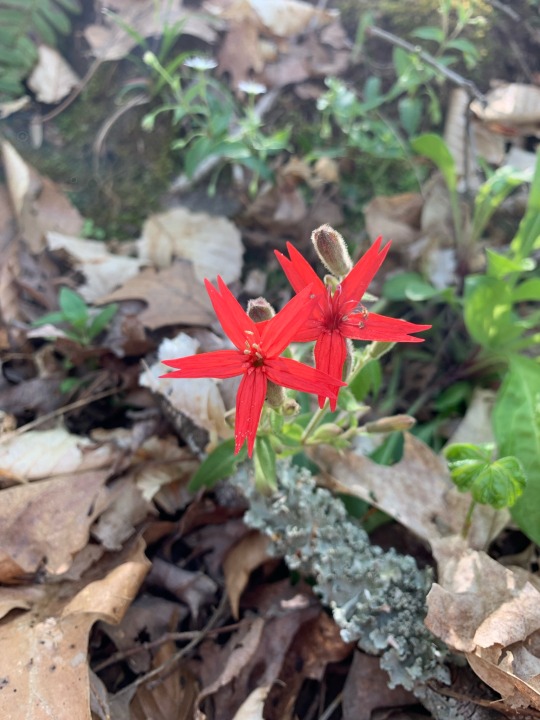
Arisaema triphyllum (jack-in-the-pulpit) / Galearis spectabilis (showy orchis) / Geranium maculatum (wild geranium) / Silene virginica (fire pink)
#flower#nature#wildflowers#naturecore#dirtcore#spring#botany#native plants#native species#native flowers#forestcore
16 notes
·
View notes
Text
Last time I tried this it loaded forever and nothing happened. So let's try again:

Oenothera speciosa (pink evening primrose)

Gaillardia xgrandiflora (blanket flower)

Allium schoenoprasum (wild chives)

Rubus allegheniensis (Allegheny blackberry)

Drymocallis arguta (tall cinquefoil)

Armeria maritima (thrift seapink)

Erigeron glabellus (streamside fleabane)

Aquilegia canadensis (Canada columbine)

Fragaria virginiana (wild strawberry)
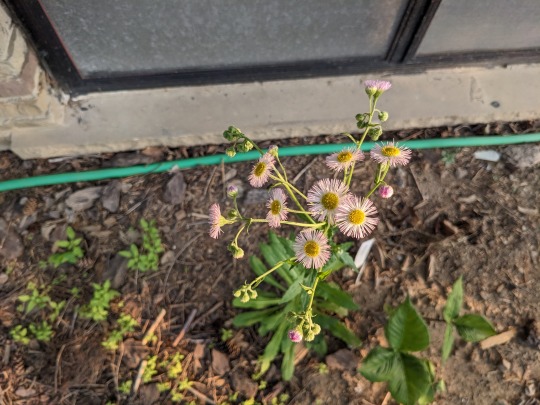
Erigeron philadelphicus (Philadelphia fleabane)

Lupinus polyphyllus (bigleaf lupine)

Mimulus guttatus (yellow monkeyflower)
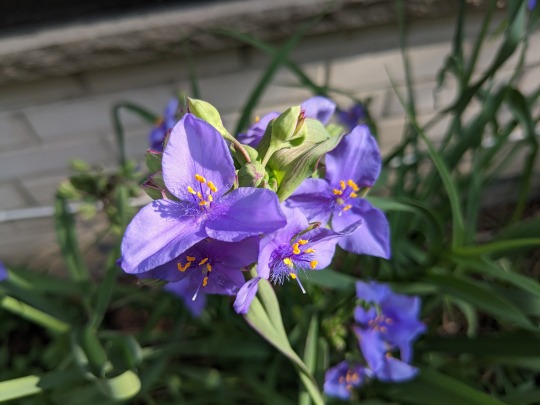
Tradescantia ohiensis (Ohio spiderwort)
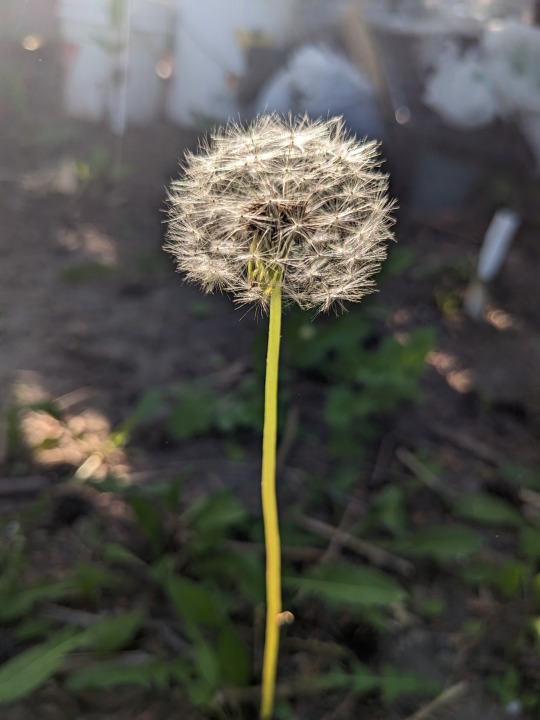
Taraxacum officinale (dandelion)

Hydrophyllum virginianum (Virginia waterleaf)

Fragaria vesca (woodland strawberry)
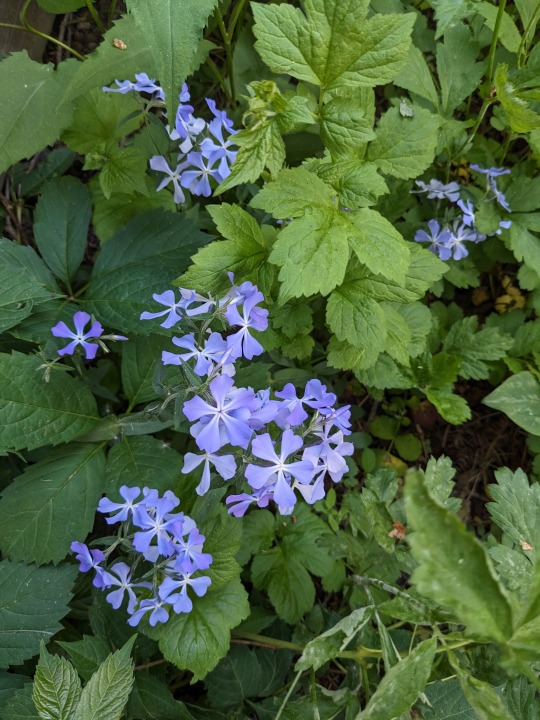
Phlox divaricata (woodland phlox)

Cerastium arvense (field chickweed)

Vaccinium angustifolium (lowbush blueberry)
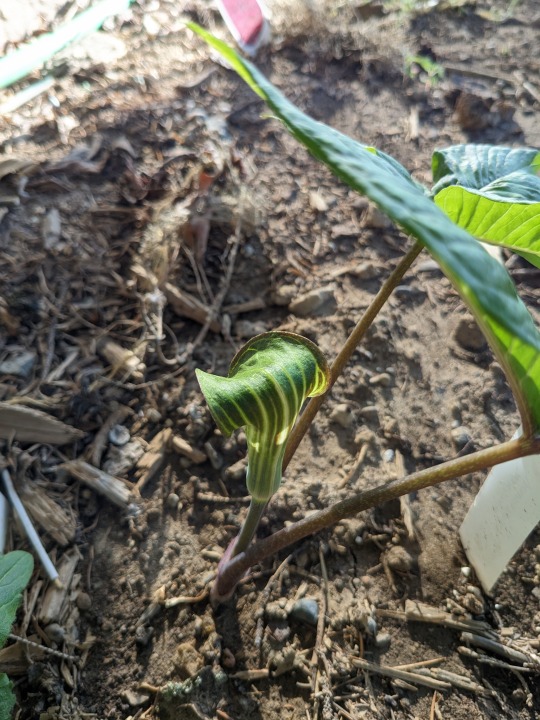
Arisaema triphyllum (jack-in-the-pulpit)

Trillium cuneatum (sweet little Betsy)

Zizia aurea (Golden alexanders)

Calctha palustris (marsh marigold)

Myosotis laxa (smallflower forget-me-not)

Trillium erectum (red wakerobin)

Uvularia grandiflora (largeflower bellwort)

Heliopsis helianthoides (sweet oxeye)

Symphyotrichum novae-angliae (New England aster)

Silphium perfoliatum (cup plant)
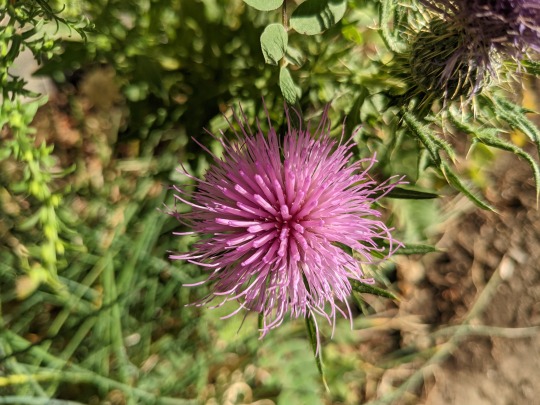
Cirsium discolor (field thistle)
And the rest will have to wait because tumblr cut me off. lol
7 notes
·
View notes
Text
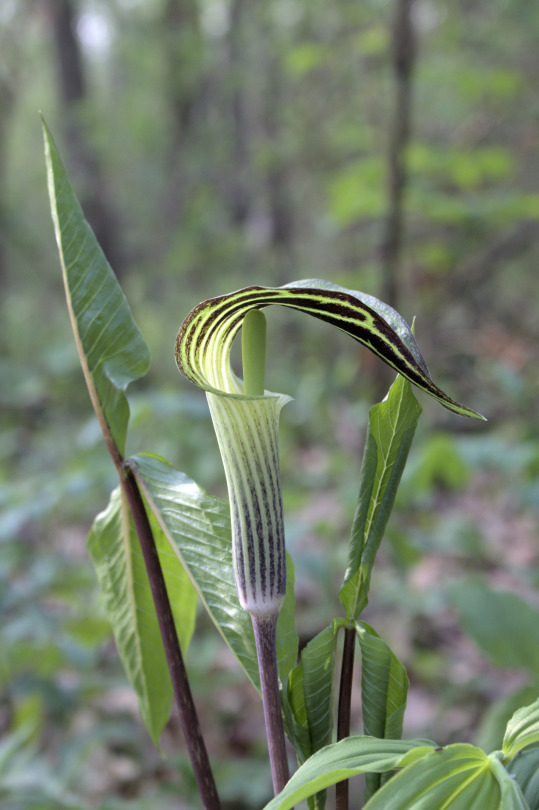

Jack-in-the-pulpits (Arisaema triphyllum) have been out in full force, and I adore them so much.
Patreon | YouTube | Twitter | Shop
78 notes
·
View notes
Text


Jack-in-the-Pulpit, Arisaema triphyllum
8 notes
·
View notes
Text

I saw this little Jack-in-the-pulpit among trout lily leaves.
#pennsylvania#wildflowers#native wildflowers#jack in the pulpit#arisaema triphyllum#arisaema#springtime#april#woodland wildflowers
309 notes
·
View notes
Text
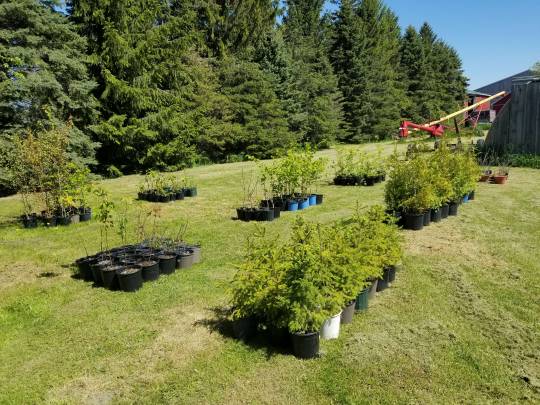


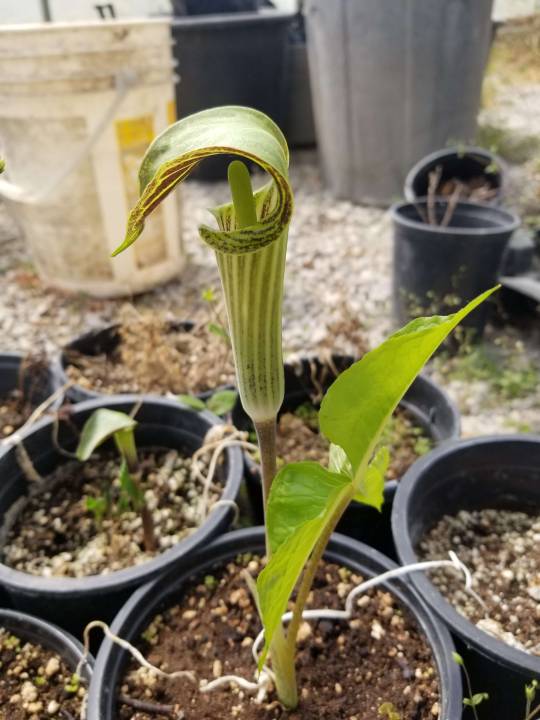
Finally posted the plants that are for sale on the facebook page. I know I don't use my tumblr for business and I don't plan to but w/e for those just curious what I've been trying to sell out on locally here it is;
Arisaema triphyllum 1 gal $8
Asclepias incarnata 'Cinderella' 1 gal $5 and $8 for larger
Asimina triloba 1 gal 7" - 15", $15
Betula alleghaniensis 25"-36"- $15
Catalpa sp. (speciosa) 22" - 34" $15
Cephalanthus occidentalis $10
Cercidiphyllum japonicum 59 "- 87" $20
Hosta 'Golden Tiara' 1 gal for $4 or $15 for larger
Iris sibirica 1 gal $8
Iris domestica 1 gal $8
Penstemon sp. 1 gal $8
Picea glauca 18" - 30" $15
Symphyotrichum novae-angliae 1 gal $5
Syringa retiuclata 27" - 43" $15
Thuja occidentalis 35" - 50" $15
am I underpricing some of these? Probably, but the quality of some of them I personally feel may have dropped since last year, and I just want them gone and in some garden soil rather than waste in a planter.
#not tagging this one since its more of personal-ish for me since I didn't wanna make it so easy to track my irl life/self#but that may not change much so meh#photos are a lil outdated by a few weeks and I know some of the stock is a lil weedy/scuffed but that comes with the exhaustion#I'm just glad I can get myself to water them daily
2 notes
·
View notes
Photo
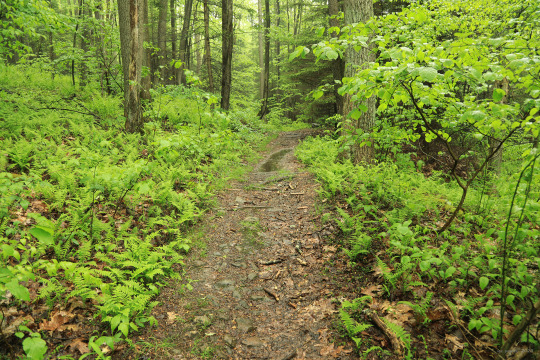
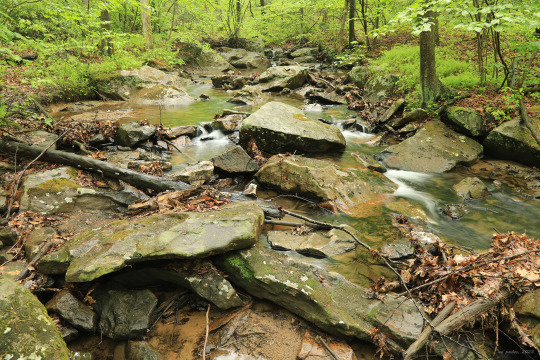




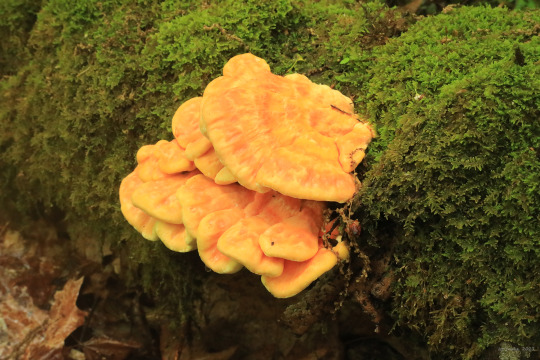


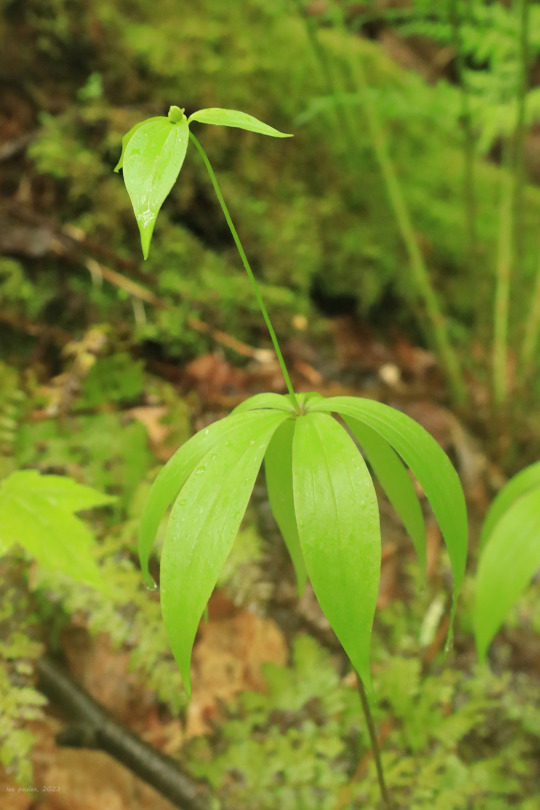
More rain in NC-WV today. As compensation, I was mesmerized by the intense green inferno of an Appalachian forest after a steady downpour. Photos from Scott Run Trail in Coopers Rock State Forest.
From top: Wild sarsaparilla (Aralia nudicaulis), whose roots were once used as a substitute for true sarsaparilla in root beer; deerberry (Vaccinium stamineum); sulphur shelf fungus (Laetiporus sulphureus); Jack-in-the-pulpit (Arisaema triphyllum) twins; a red eft, the juvenile stage of the eastern newt (Notophthalmus viridescens); and Indian cucumber (Medeola virginiana).
#appalachia#vandalia#west virginia#may#spring#wildflowers#flora#amphibian#red eft#eastern newt#wild sarsaparilla#false sarsaparilla#deerberry#sulphur shelf fungus#jack-in-the-pulpit#indian cucumber#indian cucumber-root
182 notes
·
View notes
Photo

20220503 MP271.9 Blue Ridge Parkway North Carolina
Jack-in-the-Pulpit Arisaema triphyllum
10 notes
·
View notes
Photo



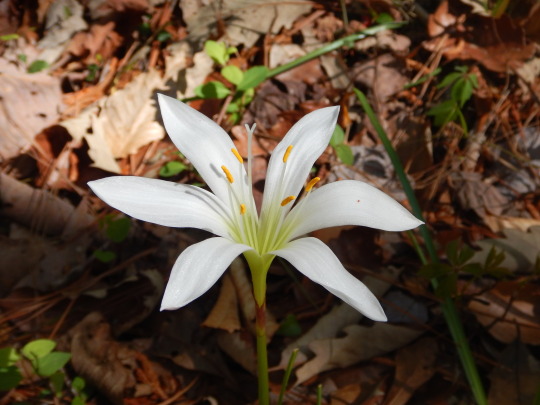



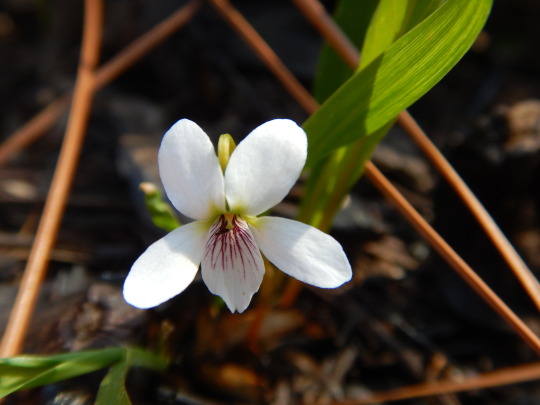


Some native spring flowers I’ve seen this year
Southern Blueflag - Iris virginica
Spurge Nettle - Cnidoscolus stimulosus
Jack-in-the-Pulpit - Arisaema triphyllum
Atamasco Lily - Zephyranthes atamasco
Cross Vine - Bignonia capreolata
Yellow Jessamine - Gelsemium sempervirens
Blue Butterwort - Pinguicula caerulea
Mountain Azalea - Rhododendron canescens
White Bog Violet - Viola lanceolata
Spotted Wakerobin - Trillium maculatum
#spring#wildflowers#iris#lily#aroid#trillium#native flowers#botany#botanist#nature#naturalist#vern's-pics#flowers
18 notes
·
View notes